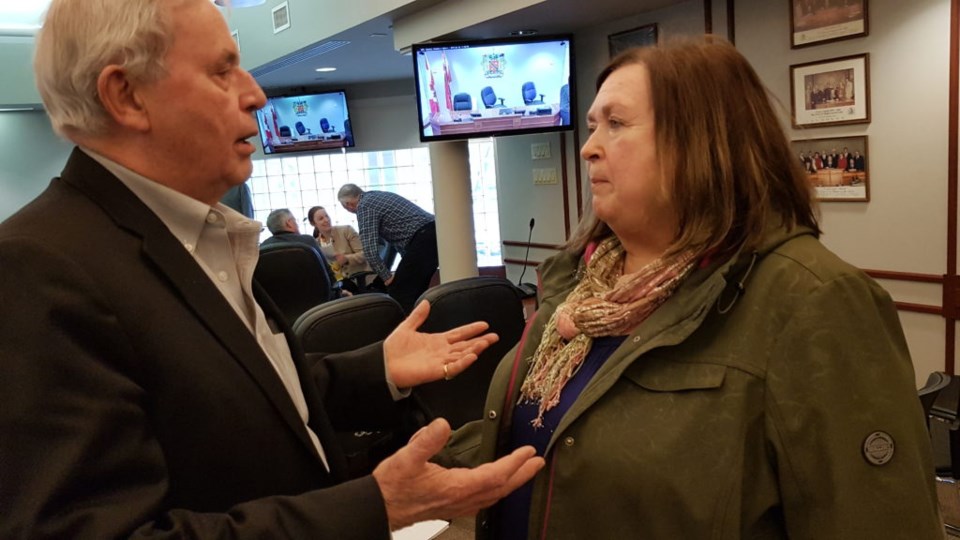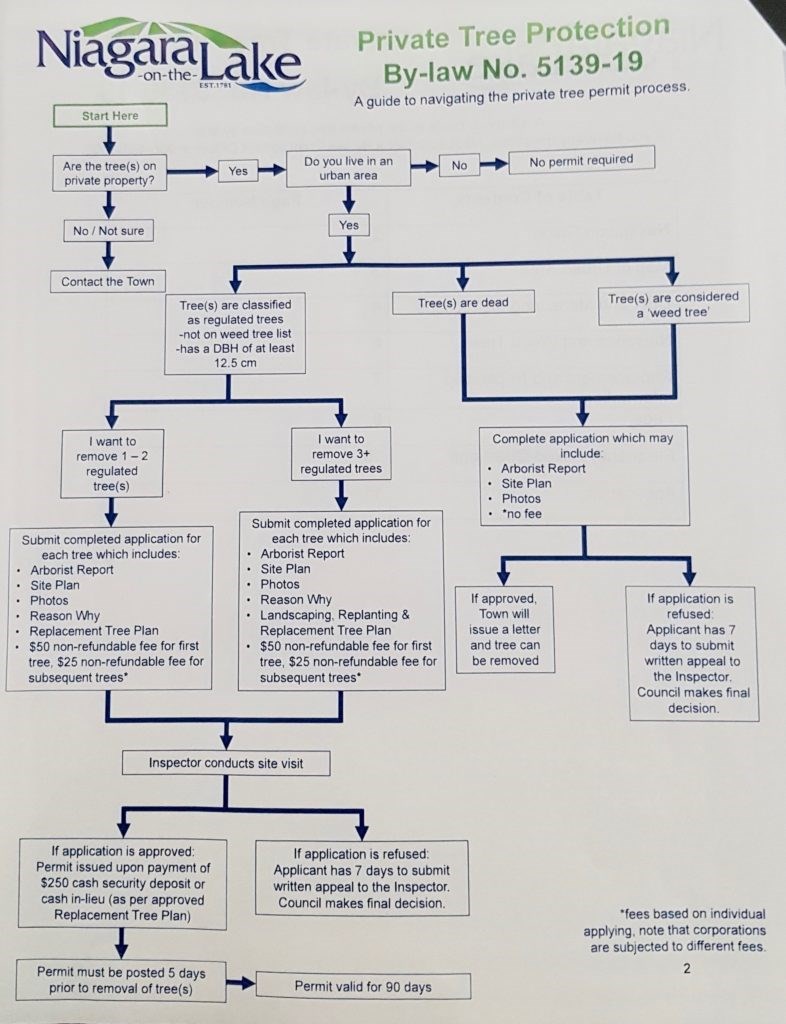
There has already been one change made to Niagara-on-the-Lake’s tree bylaw, and at least one more amended version is expected as town staff work their way through a new process, learning along the way.
The bylaw was passed quickly in December, within days of the new council being sworn in, and the first revision of it was approved in March. Another town staff report is expected in September, based on information gathered from residents and staff, and more changes are expected to follow.
Bylaw superviser Rolf Wiens and Warwick Perrin, in charge of the tree bylaw, spoke to about 50 people at an open house held Thursday at the town hall, and admitted they are still struggling with certain aspects of the bylaw.
Its goal is to preserve healthy trees within the town’s urban forest, on private properties in urban areas, and does not apply to rural areas or woodlots, explained Perrin.
Although it only applies to trees larger than a certain size in diameter, and not all trees are regulated, “we would like you to make an application for every tree you want to take down,” Perrin said. The request for an application is for “selfish reasons,” he added — if the Town gets calls from residents about a neighbour up in a tree with a chain saw, a follow-up will be easier if an application is on file, even though a permit may not be necessary.
“It’s an evolving process at the moment,” he said, referring to staff trying to discover who is taking down a tree and if approval has been granted. At one point, it took town staff several hours of investigation following a complaint to discover a tree was being taken down on town property, by town staff.
If a tree is dead or dying, or on the town’s list of nuisance and weed trees, residents are encouraged to fill out an application, and will be given a letter of permission at no cost, he said.
When asked how long that would take, he said he didn’t know. As the weather gets warmer and people come out to do yard work, the staff work load can be expected to increase. “Give us as much time as you can,” he suggested.
Wiens said it will take longer if there are several trees to be removed, due to the required arborist report. “We’re still trying to figure this out. I would hope you would give us at least a week’s notice — two weeks would be better.”
When there are several trees to be removed, a site plan and photos should also be provided, said Perrin. And if there are more than three trees to come down, a replacement plan is also required, along with an explanation of why removal is necessary.
“That’s something that’s difficult for us,” said Wiens. “If you don’t like it or think it’s too big, it’s hard for us to agree to it.” Unless it’s evident there is a problem with the tree, he added, it would be difficult for staff to approve its removal.
A permit has to be displayed on the property, and is valid for 90 days, said Perrin. If a permit is refused, the applicant has seven days to appeal, which goes to council to decide.
Each tree removed must be replaced, and depending on its size and variety, one tree can require as many as five replacements, he said. If it’s not possible onsite, the town will replant on a site of its choice.
The permit cost to an individual property owner is $50 for one tree and $25 for each subsequent one, and $250 per tree if it’s a corporation. A security deposit of $250 is required for every tree under application from an individual owner, and $500 for a corporation. The deposit is refunded once town staff investigate and confirm replacements have been planted, said Wiens.
Applications can be filled out online at notl.org/content/private-tree-removal-application-form, and are also available at the town hall.
When asked about a penalty for removing a tree without a permit, Wiens explained town staff would check the list of trees approved, either by permit or letter, and if they don’t find it, would visit the site, and as long as it’s still safe to do so, would stop it.
The Town has two charges in process for taking down trees without approval, but it’s not always easy to prove they were removed after the passing of the tree bylaw, he said.
Can a resident phone in to report a tree being taken down? Although generally bylaws are enforced on a complaint basis, if town staff see an infraction, they are instructed to phone it in, said Wiens.
“We’re still trying to develop the process.”
A bylaw officer will stop, “but it’s better to check with the office to see if a permit or letter has been issued rather than go in guns blazing.” When it comes to the tree bylaw, staff are told to be pro-active, he said.
“We’re not tree experts, but we can tell within a few days or a week if it’s a fresh cut. We’ll be charging,” he added, but without proof of when the tree was cut, “we don’t know how that will go in court. Photos would be helpful.”
Coun. Gary Burroughs told Wiens he’s had experience trying to complain — the first question he was asked was if he would be willing to testify in court.
“Was the tree taken down or not — that’s the issue, not whether we’re going to end up in court.”
An eye witness would help with a court case, and a fine has to be issued by a justice of the peace after taking a charge to court, Wiens said.
With two charges in the works now, he said, “they will give us some idea how it will go in court. Maybe we can keep neighbours out of it if we have experts involved. I don’t know that.”
Before the meeting was turned over to residents for questions, Coun. Wendy Cheropita said the comments she had heard were valid, and should be considered. “There may be some missing links because we pushed the bylaw through quickly” to get it on the books, she said, suggesting town staff work with arborists and landscapers in the community to ensure they’re familiar with the bylaw and how it works.
Coun. Stuart McCormack asked staff to consider “rephrasing this legal document” in language easier to understand, to be posted on the website.
Asked by a resident why a permit is necessary to remove an ash tree, which because of disease is likely either dead or dying, Wiens said it’s not easy to tell in the winter when there are no leaves on the tree.
“We’re not even sure how we’re going to deal with it in the middle of summer.”
The Town has an arborist on staff, “but I’m not sure we’re going to have time to send him out to check every ash tree,” he said.
One of several tree experts representing removal services said it’s not that easy to identify an ash tree, and an arborist should investigate before approval is given.
As the meeting wrapped up, Coun. Gary Burroughs said he would like to hear the responses from staff and residents before a final report is presented in September, when the bylaw is expected to undergo its last revision.
But Wiens said he thought it would be better to wait, “to get more experience with this bylaw over the summer, to collect more information and have a more comprehensive report by September.”
Talking after the meeting, Burroughs and NOTL Conservancy member Sandra O’Connor said they have concerns about the bylaw being too lenient in some areas and too onerous on residents in others — especially in relation to requiring permits for ash tree removal, noted O’Connor. In a recent presentation to the conservancy, she applauded NOTL councillors for approving the only tree bylaw for private property in the Niagara region. Noting the number of signs popping up saying, “My tree doesn’t need a bylaw,” mainly in rural areas, she said it’s important to remember the bylaw only protects trees within urban boundaries.
Regarding ash trees, she said, “a property owner should not need to incur the cost to acquire a certificate by an arborist in order to classify the tree as an ash tree. A designated town representative could declare that it is an ash tree and approve the permit to cut the tree with no costs to the property owner.”
She suggested the information on the Town’s website could be more user-friendly, and that tree protection language in the Official Plan now under review could be stronger.
Above all, she said, “transparency is needed in the process and the decision-making. Citizens have to believe that decisions are fair and can see that the process is being applied appropriately.”
Burroughs is also concerned about the way residents’ input will be treated. “Town staff have the comments. We should be reacting to them,” he said. “This is about the Town and the residents working together. It’s not about making more rules, it’s about taking great ideas and using them to protect trees. The residents are not the enemy.”
Detailed information about the tree bylaw, including a helpful navigation guide, can be found on the Town's website at https://notl.org/content/private-tree-protection.
On that page there is an interactive online version of the navigation guide: https://notl.civicweb.net/document/13946 and the reference package, which; has useful information for those considering removing a tree, is also available on that same page: https://notl.civicweb.net/document/13891.
